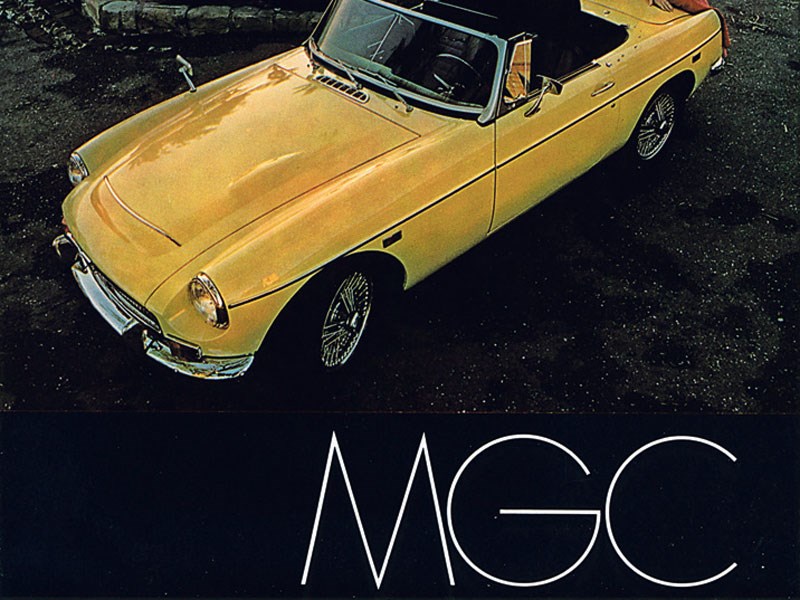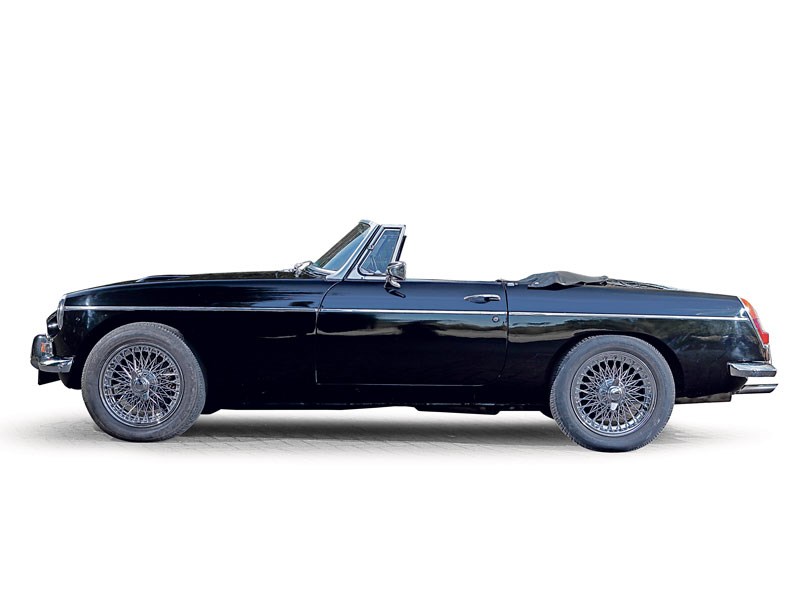The first sound heard upon starting the MGC is a soft burble from the exhaust system, similar to the MGB’s pleasant note. Increase the revs, however, and the exhaust note thickens to become distinctly more ‘six-ish’, though mellow. Oddly enough, the engine seems to lack torque at low speeds, and subjectively lacks the punch of the old Healey 3000. This fact can be explained away by the fact that the ‘C has smaller carburettors and taller gearing. It’s a lazy-feeling engine, strangely reluctant to rev – much of this is down to the heavy flywheel – but it has a lot of mid-range torque, so perhaps long-distance cruising suits it best.
You sit low in the cockpit and the steering wheel seems positively huge, often brushing the driver’s thighs. The ride quality of the ‘C is similar to the original ‘B – choppy and abrupt over poorly-surfaced roads, but otherwise fairly soft in normal conditions. What it lacks in refinement, however, is made up for with a liberal dose of performance of the kind the four-pot B simply can’t deliver.
VITAL STATISTICS
1967 MGC
Engine 2912cc/6-cyl/OHV
Power (bhp@rpm) 145bhp@5250rpm
Torque (lb ft@rpm) 120lb ft@3400rpm
Top speed 120mph
0-60mph 10sec
Consumption 19mpg
WHAT TO LOOK FOR
BODYWORK & CHASSIS
Although the MGB and MGC bodyshells look similar – both roadster and GT versions – the underside from the front seats forward and the inner front wings bear no relationship to each other. This is important when assessing a prospective purchase, especially if structural repairs are required, as replacement panels are largely unobtainable. Scrutinise all panel edges, especially doors, footwells, bootlid, boot floor and corners, battery boxes and wheelarches. Notable rust spots are around the front headlamps and sidelight clusters. Bubbling here is a fair indication that either work will be required, or shoddy repairs are disguising trouble beneath.
Blistering under the paint around the fillet strips fitted to the point where the front wings meet with the scuttle panel and also to the top edge of the rear wings usually indicate future problems. In the case of the front wings, major remedial work will almost certainly be needed underneath. The turret box sections to the top of the front wings are also a notorious area for corrosion, as road dirt thrown up by the front wheels builds up. If left unattended, rot here can stretch further back to the A-posts.
The majority of MGC bonnets were made from aluminium, making them prone to dents from stones. Replacements are expensive, so many have been swapped for steel versions. The transverse stainless steel bonnet strip sometimes causes galvanic corrosion with the aluminium bonnet where the retaining bolts are situated. If caught early this won’t result in serious damage, but is worth considering as a haggling point.
Pay special attention to the underfloor triangular box section through which the torsion bars pass. Most important, however, are the sills. The strength of the monocoque body is dependent on the integrity of the box sections running between the front and rear wheelarches. The sill section compromises the outer sill, inner sill, a vertical closing panel and the ‘castle rail’. The last of these is a horizontal panel running underneath the length of the sill. Rust in any of these vital areas is usually only apparent when bubbles start to appear on the outer sill. Unfortunately, by this point, irreparable damage has been done – once the inner sill has succumbed to corrosion, the only remedy is complete – not to mention expensive – sill replacement.
ENGINE
The MGC’s engine and gearbox rarely give cause for concern, largely due to the laid-back attitude of the strong three-litre powerplant. Regular servicing is advisable, but a well-maintained C engine will cover 150,000 miles without complaint. Most cars available today will have had a rebuild anyway, often as part of a full mechanical and bodyshell rebuild. Non-overdrive MGCs used identical internal ratios to the MGB MkII, but all others used a unique set of internal ratios, so it pays to find out if the correct unit is fitted. The long-lasting Borg Warner Type 35 automatic transmission was also offered in the MGC and was surprisingly popular, being fitted to around 15 per cent of the production run.
ELECTRICS
The top-model 300SE and 300SEL had air suspension, which was high-tech stuff for the early 1960s. The ride it gives is quite remarkable, but problems can be very expensive indeed to fix, and parts are not plentiful. Buy an air-sprung Fintail with your eyes wide open, and have the phone numbers of a specialist and your bank manager close at hand.
BRAKES
Either five-stud pressed steel wheels with chrome disc trims or painted 15-inchdiameter centre-lock wire wheels were fitted from the factory. With the latter, make sure all the spokes are in good shape and that the splines aren’t worn. You can do this by jacking up the rear of the car, then trying to turn the wheel backwards and forwards while somebody else presses the brake pedal
INTERIOR
The footwell mats, inner sill and driver’s footrest coverings were originally made from rubber, although many of these have perished over the years, resulting in replacement with carpet when replacements proved difficult to source. Most trim is still available, but if you need to refresh a tired interior you will find that the costs will soon start to mount, so keep this bargaining point in mind when viewing.
OUR VERDICT
The MGC isn’t really nimble enough to be classed as a true sports car., nor is it quite as well balanced as the ’B . The cast iron six–cylinder engine is heavy; engineers could not mount it far enough back in the engine bay to spread its weight over the entire chassis. Consequently, the MGC is somewhat nose–heavy. but it scores as a comfortable long-distance cruiser. The ‘C offers the classic MGB looks, but with added refinement, making it well suited to today’s classic market. Modern 185/70 radial tyres reduce understeer and minor changes will improve the handling even more. The six-cylinder engine – similar to the Healey 3000 but actually better – is shared only with the Austin 3-litre, and responds well to simple tweaks. But as a tourer with an easy turn of speed and relaxed overdrive cruising, a well-sorted MGC is already a decent contender.
A six-cylinder MG sports car had been suggested by Syd Enever’s team at Abingdon in the late 1950s, before the original MGB design was signed off. However, the venerable Austin-Healey 3000 was top of the BMC sports car ladder, so it was only when that model was phased out that the prospect of a six-cylinder MGB came to fruition.
The MGC required extensive changes to the front end of the bodyshell, plus all-new front suspension. The engine was a mix of features from the earlier C-series and 2.4-litre Blue Streak motor fitted to the Australian Austin Freeway and Wolseley 24/80. Heavier than the 1798cc MGB engine, it altered the vehicle’s handling, meaning it received a mixed response in the automotive press. The C was cancelled in 1969 after two years of production.
Today, the model is highly collectible and the poor handling has been improved by better tyres and modification of the suspension settings. Tuning of the under-developed straight-six is common, and tweaking to the head, exhaust and cam release as much as 30 per cent more power and torque.



